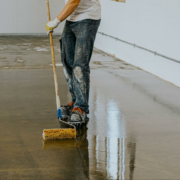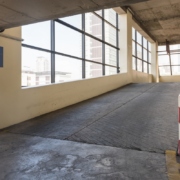Fighting the Danger of Overprotection on Concrete Repairs

Is it possible to give concrete too much protection against reinforcement corrosion? Research indicates that this is so, although no consensus exists on the exact mechanisms and how to avoid it. However, following logical reasoning, Cortec® recommends applying Migrating Corrosion Inhibitors to mitigate the problem.
What is overprotection?
Overprotection occurs when metal reinforcement in one part of the concrete is more protected than in another. This can happen when a new concrete patch is laid, replacing contaminated or carbonated concrete with uncontaminated concrete that has a high pH and therefore a naturally protective alkaline environment. The resulting difference in corrosion potential between the patch and the adjacent concrete eventually leads to corrosion in surrounding areas, thus transferring the original problem elsewhere. This is known as the ring anode/halo effect.
Examples of overprotection
Overprotection can also happen in a variety of other ways. One is through the common practice of cathodic protection (CP). The challenge of calculating the appropriate number of anodes for an area and removing concrete to install them is compounded by the fact that it is not possible to gain access to and treat all parts of the rebar equally.
This leaves some portions of the metal reinforcement with more protection than others, an imbalance that could show itself over time by corrosion in areas with less protection. A similar effect may happen with the application of an epoxy coating to one part of a rebar and not to another. Using other corrosion protection measures may cause a similar imbalance when over-applied.

Even Out the Corrosion Potential
The use of MCI® Surface Applied Corrosion Inhibitors (SACIs) makes it easier to balance out the corrosion potential. Rather than leaving a well-protected patch surrounded by chloride-contaminated concrete, contractors can apply MCI® SACIs to the undisturbed concrete to reduce the difference in corrosion potential between the two portions.
Fortunately, MCI® SACIs are easy to apply by spraying onto the concrete like a standard surface treatment. As time progresses, Migrating Corrosion Inhibitors in the MCI® SACI work their way deeper in through the concrete pores toward the metal reinforcement. Their metal affinity allows them to form a protective molecular layer on the embedded rebar when they encounter it.

MCI® SACI Options
MCI®-2020 contains the highest concentration of surface applied Migrating Corrosion Inhibitors on the market and is therefore the number one recommended SACI for this purpose. Typically, a coating or water repellent should be applied on top of this to keep moisture out and MCI® in.
Two-in-one MCI®/ water repellents are also available for greater convenience, albeit with smaller doses of Migrating Corrosion Inhibitors (MCI®-2018 combines MCI® with a 100% silane water repellent, and MCI®-2019 combines MCI® with a 40% silane water repellent).
Take a Balanced Approach to Corrosion Protection
Concrete repairs are too labour-intensive to make the mistake of overprotection. By being sure to protect the concrete around the patch area with Migrating Corrosion Inhibitors, contractors can take one step ahead of the chain reaction of corrosion that is common in less protected areas. Contact Cortec® to learn more about the advantages of mitigating corrosion in reinforced concrete with MCI®.





